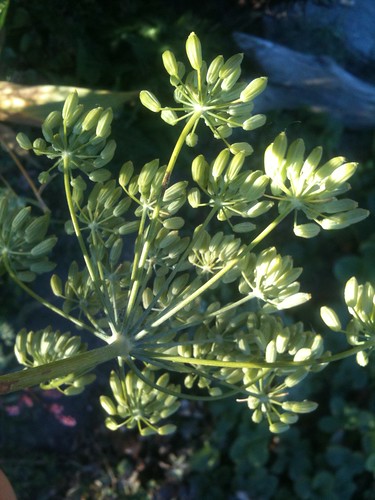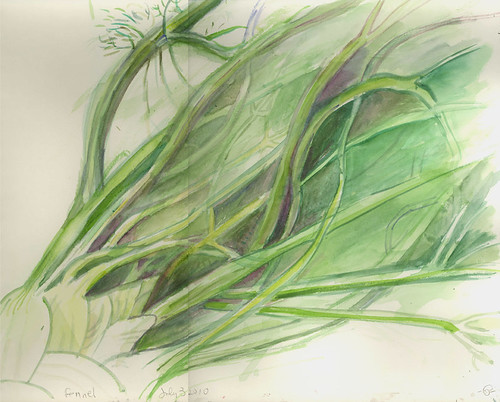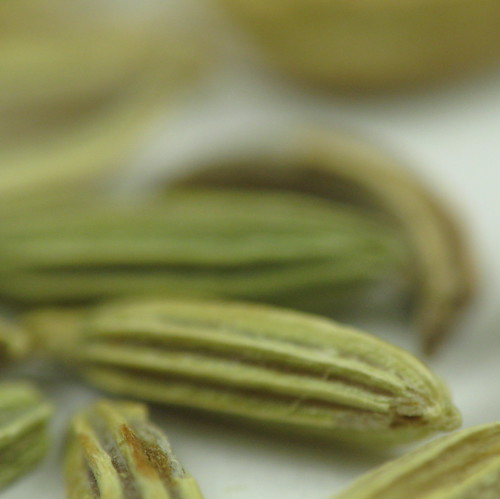Fennel
Fennel , a photo by Marcia Milner-Brage on Flickr.
Fennel (Foeniculum vulgare) grows wild in the Mediteranean region. The wild fennel is called "bitter fennel" and cultivated fennel, also known as "sweet fennel" originated in the island of Malta, and discovered by crusaders who brought it to Europe about 1000 years ago. Growing up in the Galilee in Israel, we would find wild fennel in the winter and chew on them for their sweet aroma, or bring them home to our mother who added the feathery leaves to lentil stews and soups, or fresh into the salad just like you would with dill or parsley. Fennel seeds are common as breath-fresheners in India. The seeds also find their way into countless curries and garam masala recipes, as well as chai blends, where their sweetness balances the astringency of Indian black tea. Fennel culinary uses far outnumber it's applications in perfumery. Its sweet, warm, fresh licorice-like aroma finds many uses in flavouring preparations from liquros and aperitifs, to syrups, cough drops and lozenges, as well as to season pickles and marinade fish and seafood. The last use, as well as its medicinal applications, has a scientific reasons behind it: the main chemical compound in fennel seed, anethole, is a powerful masking agent! You can find fennel seeds in Moroccan savoury pretzels and semoline cookies and desserts alike - not to mention Italian biscotti and how well it goes with orange zest. Fennel is more versatile that might seem at first to the untrained cook.
The fresh bulbs have many wonderful recipes in the Mediterranean region and you will find it in the Italian and Moroccan cuisines, where it's praised and prepared with reverence and consumed with much delight. The crisp bulbs are especially favoured, used fresh in salads, or roasted, grilled or caramelized for appetizers and antipasti.

In contrast to this versatility - fennel rarely takes the centre stage in perfumery. Synthetic anethole is widely used to mask unpleasant odours in various industrial products, and that's about where its role ends. Synthetic anethole is preferred, because it is much cheaper to produce than to distill it from seeds of anise, fennel or star anise fruit. However, synthetic anethole also contains a toxic chemical called cis-anethole (which is not present in the natural oils of the above plants). You'd be hard-pressed to find any perfume of significance containing fennel as a note commercially. Fennel is a top note, so no matter how much someone might like it, it won't take centre stage for too long, even if it was allowed to. And then there is the other question - is there really any difference between fennel and other licorice-smelling notes?
The answer is, there is - though quite subtle. While aniseed has a very sweet-warm personality, and star anise an even cleaner, almost woody version of licorice - fennel has a bit of a fizzy green feel to it. You'd have to look at it with a magnifying glass (olfactorily speaking, of course) to find this out - but eventually you will be able to discriminate them in a blind test. In fact, it was one of the times I noticed that perhaps my nose is can differentiate such fine differences: I was in an aromatherapy store with a friend, and he spontaneously decided to blind-test me. I've ID'd it as fennel right away.
And why all this fennel talk, you might be wondering? It is seasonal - the bulbs are at the farmers' market, to my delight; and a surprise of green fennel seeds in Sunset Beach (which I used in a salad recipe with Asian pears). But my perfumery point of view on this actually comes from a surprising angle - my experiments with osmanthus absolute, furthering my acquaintance with this rare absolute brought me fennel seed again. I remembered fondly the Chartreuse Eau de Vie tisane and just had to try blending osmanthus with chamomile and fennel. Incidentally, I've also come across since with the liquor that inspired it (pricey, but worth it). It's so complex and delicious, reminiscent of honeyed herbal tea more than an alcoholic beverage. I'm not much of a drinker so it might take me a while to come up with a cocktail including that; but I will sure share it with you once I nail down something outsanding. For now I was just diluting it with San Pellegrino with much delight.
And just like the untrained cook - the beginner perfumer will only think of fennel as a whimsical, edible note to work alongside other licorice like notes (aniseed, star anise, tarragon) and other candy-like notes (sweet orange, vanilla, cacao) to produce a licorice candy effect. But it would take more imagination and adventurous experimentation to unearth fennel's beautiful life alongside Moroccan roses, apricot-like magnolias, fruity-apply chamomile, and spectacular, precious osmanthus. And I've only just scratched the surface of the surprising effects such combinations can create.



